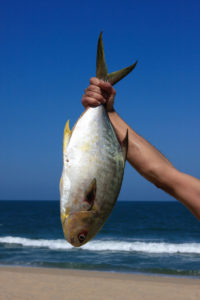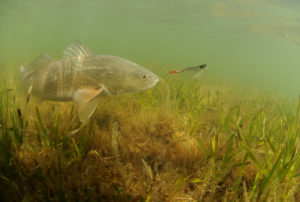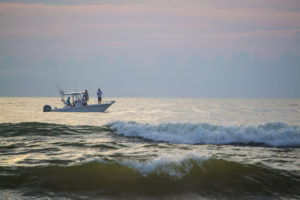Understanding how tides and currents influence your fishing outings can mean the difference between a successful catch and a disappointing day on the water.
To begin your journey into this realm of knowledge, let’s break down the key steps in comprehending how tides and currents impact your fishing endeavors:
1. What Causes Fishing Tides
To start, let’s delve into the fundamental causes of fishing tides. Tides are primarily driven by the gravitational pull of the moon and the sun on Earth’s oceans.
These gravitational forces create the rhythmic rise and fall of sea levels, resulting in the ebb and flow of water. These tidal movements play a crucial role in determining when and where fish are most active.

2. Understanding the Impact of Saltwater Tides on Fishing
Saltwater tides have a profound impact on the behavior of marine life, particularly fish. As the tide rises, water moves onto the shore, flooding previously dry areas and providing access to forage for various species.
During the ebbing tide, water recedes, causing fish to move into deeper waters. Being aware of these tidal movements can help you predict where fish will be located and how they’ll react to changing water levels.
3. Reading Tide Charts and Tide Tables
To decipher the ebb and flow of tides, you’ll need to become familiar with reading tide charts and tables.
Tide charts depict the water levels throughout a saltwater bay or estuary area over a specific time period. They visually illustrate the rise and fall of tides, enabling you to plan your fishing excursions during optimal tidal conditions.
Alternatively, tide tables offer daily predictions of high and low tides for a specific fishing spot. These tables provide essential information for selecting the most promising times to cast your line.
4. Timing Your Fishing Adventures
Armed with tide charts or tide tables, you can strategically time your fishing trips to coincide with periods of heightened tidal activity.
Pay attention to the transition points between high and low tides, known as “slack tides.”
During these moments, water movement slows down, making it easier for fish to feed without expending excessive energy. Planning your fishing during slack tides can increase your chances of encountering actively feeding fish.

5. Adjusting Techniques and Strategies
Different tidal and current conditions may necessitate adjustments to your fishing techniques.
For instance, strong currents might require using heavier weights or specialized rigs to keep your bait at the desired depth. Adapting your tactics to the prevailing conditions is essential for enticing bites and reeling in your target species.
As you embark on this journey of understanding tides and currents, you’ll gain the ability to anticipate the movements of fish based on tidal rhythms.
Armed with this knowledge, you’ll be better equipped to choose the right times, spots, and techniques for a successful saltwater fishing experience.
Explore a wealth of insights in our detailed guide: ‘Essential Saltwater Fishing Tips.‘ Uncover angling secrets, gear mastery, and elevate your fishing success.
Making the Most of Tidal Variations: Tips for Strategic Fishing
As you become more attuned to the ebb and flow of tides, you can take your saltwater fishing game to the next level by employing advanced strategies that leverage the nuances of tidal variations.
These techniques allow you to maximize your chances of landing prized catches during different tidal phases:
Understanding Tidal Range
Tidal range refers to the difference in water level between high tide and low tide. A larger tidal range can lead to more dramatic changes in water depth, affecting fish behavior.
During a higher tidal range, fish may move farther inland with the rising tide, while a lower range might concentrate them in specific channels or areas. Knowing the tidal range for your fishing location can help you predict where fish will congregate.

Capitalizing on Current Edges
As water moves with the tides, it creates current edges along structures like drop-offs, reefs, and points. These current edges are prime spots for finding actively feeding fish.
Predatory species often position themselves near these edges, waiting to ambush prey being carried by the current. Casting your line strategically along these edges can lead to successful hookups.
Gear up for angling excellence with our guide: ‘Essential Saltwater Fishing Gear: A Comprehensive Guide.’ Unlock the tools you need for a successful fishing experience. Dive in to discover your complete angler’s toolkit.
Transition Periods Slack Tides and Changing Conditions
While slack tides can be ideal for certain types of fishing, transitional periods between changing tidal conditions can also trigger feeding frenzies.
As the tide shifts from ebbing to flowing (or vice versa), fish may become more active as they adjust to the changing water movement. Casting your bait during these transition periods can entice strikes from opportunistic fish.
Focusing on Structure-Associated Fish
Different fish species have varying preferences for structure. During the incoming tide, predatory fish might move closer to the shorelines and shallower areas to capitalize on the abundance of prey being carried in by the tide.
Conversely, as the tide recedes, fish could retreat to deeper channels or structures. Tailoring your approach based on species-specific behavior can lead to more successful outings.
Experimenting with Bait Presentation
Tidal movements can affect how fish perceive and locate your bait. During strong currents, fish might have a limited window to identify and strike your offering.
Consider adjusting your bait presentation to ensure it’s visible and enticing amidst the water movement. This could involve altering retrieval speeds, using scent attractants, or modifying bait size and color.
By delving into these advanced strategies, you’ll not only adapt to the ever-changing dynamics of tides and currents but also increase your ability to read the water like a seasoned angler.
Embrace the challenge of aligning your tactics with the rhythms of the sea, and you’ll discover a whole new dimension of saltwater fishing success.

Unlock the art of successful fishing with our guide: ‘Saltwater Fishing: Ultimate Guide to Choosing the Best Bait.‘ Elevate your catch rate and angling expertise. Dive in for invaluable insights – start reading today!
In the world of saltwater fishing, understanding and harnessing the power of tides and currents is a transformative skill that can elevate your angling pursuits to remarkable heights.
As you’ve discovered throughout this exploration, the interplay between tidal movements and fish behavior is a complex yet rewarding relationship.
By delving into the intricacies of tidal patterns, adjusting your strategies, and capitalizing on the nuances of each tidal phase, you’ve unlocked the secrets to strategic fishing success.
From the basics of reading tide charts and tide tables to the advanced techniques of exploiting current edges and transitional periods, you’ve embraced a holistic approach to saltwater angling.
Armed with this knowledge, you’re poised to venture out onto the water with heightened confidence and a deep understanding of the underwater world’s ever-changing rhythms.
Remember that while mastering the tides and currents requires time and experience, the rewards are more than worth the effort.
Each successful catch you land, each fish you hook, and each thrilling moment you experience while riding the tidal currents reinforces the wisdom you’ve gained.
So, go forth with your newfound expertise, cast your line with intention, and let the tides guide you toward unforgettable encounters with the ocean’s finest inhabitants. Happy fishing!



